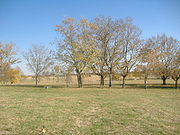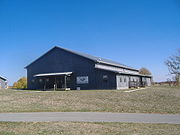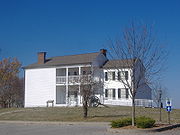
Camp Nelson Civil War Heritage Park
Encyclopedia
The Camp Nelson Civil War Heritage Park is a 525 acres (2.1 km²) historical museum and park located in southern Jessamine County, Kentucky
, 20 miles (32.2 km) south of Lexington, Kentucky
. It was established in 1863 as a depot for the Union army during the Civil War
and became a recruiting ground for new soldiers from eastern Tennessee and escaped slaves, many of whom trained to be soldiers.
above the state capital (Frankfort, Kentucky
). The site was selected to protect the bridge, to have a base of operations in central Kentucky, and to prepare to attack the Cumberland Gap
and eastern Tennessee. The camp was also to train new soldiers for the Union army. The Kentucky River's steep palisade
s contributed to the selection of the site—they would help defend the camp from Confederate attack.
 Camp Nelson may have been the best choice for a central Kentucky depot, but it was inadequate. When Union Major General Ambrose Burnside
Camp Nelson may have been the best choice for a central Kentucky depot, but it was inadequate. When Union Major General Ambrose Burnside
attacked the Cumberland Gap and Knoxville, Tennessee
, Camp Nelson's distance from the Gap and Knoxville, combined with lack of railroads and the weather, hampered the Union advance. When overall Union commander Ulysses S. Grant
visited Camp Nelson in January 1864, he was displeased, observing that "no portion of our supplies can be hauled by teams from Camp Nelson". The situation of the camp had not improved by spring of 1864, and Grant leaned towards abandoning it entirely. William Tecumseh Sherman
advocated that its role be diminished instead, which saved Camp Nelson as it gave the camp time to establish itself for its role of training black soldiers.
In July 1863 and June 1864 it was feared that Confederate general John Hunt Morgan
would attack the camp. However, in 1863 Morgan was headed for Indiana
and Ohio
in his most famous raid
. It was never confirmed whether he intended to attack the camp in 1864.
 In August 1863 thousands of slaves forced to build railroads for the Union army were stationed at Camp Nelson. Called "contrabands", these former slaves, at least 3,000 in number, were the primary builders of Camp Nelson starting with fortifying Hickman Bridge on May 19, 1863. This impressment meant that Kentucky would not see its first black enlistment until 1864, while the other border states saw it in October 1863.
In August 1863 thousands of slaves forced to build railroads for the Union army were stationed at Camp Nelson. Called "contrabands", these former slaves, at least 3,000 in number, were the primary builders of Camp Nelson starting with fortifying Hickman Bridge on May 19, 1863. This impressment meant that Kentucky would not see its first black enlistment until 1864, while the other border states saw it in October 1863.
At Camp Nelson 10,000 African-Americans were given emancipation from slavery in exchange for service in the Union army. These soldiers sometimes brought their families to Camp Nelson; such refugees totaled 3,060 and were cared for by missionaries. At one point, in November 1864, Camp Nelson was not a legal place of refuge for slaves, forcing 400 women and children to leave the camp at Union army gunpoint; the refugees suffered 102 deaths due to weather until brought back to camp. Even then, 1,300 refugees died during Camp Nelson's existence. Camp Nelson was the smallest of the three locations where blacks were trained to become Union soldiers; the others were in Boston, Massachusetts, and New Orleans, Louisiana
. Camp Nelson is the only one whose land was never developed.
The largest number of African-American recruits came between June and October 1864, with 322 men enlisting on a single day on July 25. After that, the rest of 1864 saw only 20 new recruits, with January seeing only 15 and the period between February to April seeing only six. Among the units raised at Camp Nelson were the 5th and 6th U.S. Colored Cavalry Regiments and the 114th and 116th Colored Heavy Artillery Regiments.
After the war, Camp Nelson was a center for giving ex-slaves their emancipation papers, causing many of them to consider the camp as their "cradle of freedom".
 Presently, 525 acres (2.1 km²) of the original property are preserved as the Camp Nelson Civil War Heritage Park. Most of the buildings at the camp were sold.
Presently, 525 acres (2.1 km²) of the original property are preserved as the Camp Nelson Civil War Heritage Park. Most of the buildings at the camp were sold.
Camp Nelson is currently controlled by the Jessamine County Fiscal Court. There are efforts to turn control of Camp Nelson to the National Park Service
. These efforts were aided once Camp Nelson became part of the National Underground Railroad Network to Freedom, and U.S. Representative Ben Chandler
is considering funding to see if such a transfer is feasible.
 At the park is the Oliver Perry House, the only structure from its day at a camp that still stands. It was built in about 1846 for the newlywed couple of Oliver Perry and the former Fannie Scott. General Burnside confiscated the house during the war to serve as officers quarters. In many official letters, the house was called the "White House". It currently serves as a historic house museum for the park.
At the park is the Oliver Perry House, the only structure from its day at a camp that still stands. It was built in about 1846 for the newlywed couple of Oliver Perry and the former Fannie Scott. General Burnside confiscated the house during the war to serve as officers quarters. In many official letters, the house was called the "White House". It currently serves as a historic house museum for the park.
There is over a mile of walking paths at the park. Ghost tours are occasionally available.
Camp Nelson National Cemetery
is two miles to the south.
Jessamine County, Kentucky
Jessamine County is a county located in the U.S. state of Kentucky. It is within the Inner Blue Grass region, which was the center of farming and blooded stock raising, including thoroughbred horses. It was formed in 1799. The population was 48,586 in the 2010 Census...
, 20 miles (32.2 km) south of Lexington, Kentucky
Lexington, Kentucky
Lexington is the second-largest city in Kentucky and the 63rd largest in the US. Known as the "Thoroughbred City" and the "Horse Capital of the World", it is located in the heart of Kentucky's Bluegrass region...
. It was established in 1863 as a depot for the Union army during the Civil War
American Civil War
The American Civil War was a civil war fought in the United States of America. In response to the election of Abraham Lincoln as President of the United States, 11 southern slave states declared their secession from the United States and formed the Confederate States of America ; the other 25...
and became a recruiting ground for new soldiers from eastern Tennessee and escaped slaves, many of whom trained to be soldiers.
Early history
Camp Nelson was established as a supply depot for Union invasions into Tennessee. It was named for Major General William "Bull" Nelson, who had recently been murdered. It was placed near Hickman Bridge, the only bridge across the Kentucky RiverKentucky River
The Kentucky River is a tributary of the Ohio River, long, in the U.S. state of Kentucky. The river and its tributaries drain much of the central region of the state, with its upper course passing through the coal-mining regions of the Cumberland Mountains, and its lower course passing through the...
above the state capital (Frankfort, Kentucky
Frankfort, Kentucky
Frankfort is a city in Kentucky that serves as the state capital and the county seat of Franklin County. The population was 27,741 at the 2000 census; by population it is the 5th smallest state capital in the United States...
). The site was selected to protect the bridge, to have a base of operations in central Kentucky, and to prepare to attack the Cumberland Gap
Cumberland Gap
Cumberland Gap is a pass through the Cumberland Mountains region of the Appalachian Mountains, also known as the Cumberland Water Gap, at the juncture of the U.S. states of Tennessee, Kentucky, and Virginia...
and eastern Tennessee. The camp was also to train new soldiers for the Union army. The Kentucky River's steep palisade
Palisade
A palisade is a steel or wooden fence or wall of variable height, usually used as a defensive structure.- Typical construction :Typical construction consisted of small or mid sized tree trunks aligned vertically, with no spacing in between. The trunks were sharpened or pointed at the top, and were...
s contributed to the selection of the site—they would help defend the camp from Confederate attack.

Ambrose Burnside
Ambrose Everett Burnside was an American soldier, railroad executive, inventor, industrialist, and politician from Rhode Island, serving as governor and a U.S. Senator...
attacked the Cumberland Gap and Knoxville, Tennessee
Knoxville, Tennessee
Founded in 1786, Knoxville is the third-largest city in the U.S. state of Tennessee, U.S.A., behind Memphis and Nashville, and is the county seat of Knox County. It is the largest city in East Tennessee, and the second-largest city in the Appalachia region...
, Camp Nelson's distance from the Gap and Knoxville, combined with lack of railroads and the weather, hampered the Union advance. When overall Union commander Ulysses S. Grant
Ulysses S. Grant
Ulysses S. Grant was the 18th President of the United States as well as military commander during the Civil War and post-war Reconstruction periods. Under Grant's command, the Union Army defeated the Confederate military and ended the Confederate States of America...
visited Camp Nelson in January 1864, he was displeased, observing that "no portion of our supplies can be hauled by teams from Camp Nelson". The situation of the camp had not improved by spring of 1864, and Grant leaned towards abandoning it entirely. William Tecumseh Sherman
William Tecumseh Sherman
William Tecumseh Sherman was an American soldier, businessman, educator and author. He served as a General in the Union Army during the American Civil War , for which he received recognition for his outstanding command of military strategy as well as criticism for the harshness of the "scorched...
advocated that its role be diminished instead, which saved Camp Nelson as it gave the camp time to establish itself for its role of training black soldiers.
In July 1863 and June 1864 it was feared that Confederate general John Hunt Morgan
John Hunt Morgan
John Hunt Morgan was a Confederate general and cavalry officer in the American Civil War.Morgan is best known for Morgan's Raid when, in 1863, he and his men rode over 1,000 miles covering a region from Tennessee, up through Kentucky, into Indiana and on to southern Ohio...
would attack the camp. However, in 1863 Morgan was headed for Indiana
Indiana
Indiana is a US state, admitted to the United States as the 19th on December 11, 1816. It is located in the Midwestern United States and Great Lakes Region. With 6,483,802 residents, the state is ranked 15th in population and 16th in population density. Indiana is ranked 38th in land area and is...
and Ohio
Ohio
Ohio is a Midwestern state in the United States. The 34th largest state by area in the U.S.,it is the 7th‑most populous with over 11.5 million residents, containing several major American cities and seven metropolitan areas with populations of 500,000 or more.The state's capital is Columbus...
in his most famous raid
Morgan's Raid
Morgan's Raid was a highly publicized incursion by Confederate cavalry into the Northern states of Indiana and Ohio during the American Civil War. The raid took place from June 11–July 26, 1863, and is named for the commander of the Confederates, Brig. Gen...
. It was never confirmed whether he intended to attack the camp in 1864.
Black history

At Camp Nelson 10,000 African-Americans were given emancipation from slavery in exchange for service in the Union army. These soldiers sometimes brought their families to Camp Nelson; such refugees totaled 3,060 and were cared for by missionaries. At one point, in November 1864, Camp Nelson was not a legal place of refuge for slaves, forcing 400 women and children to leave the camp at Union army gunpoint; the refugees suffered 102 deaths due to weather until brought back to camp. Even then, 1,300 refugees died during Camp Nelson's existence. Camp Nelson was the smallest of the three locations where blacks were trained to become Union soldiers; the others were in Boston, Massachusetts, and New Orleans, Louisiana
New Orleans, Louisiana
New Orleans is a major United States port and the largest city and metropolitan area in the state of Louisiana. The New Orleans metropolitan area has a population of 1,235,650 as of 2009, the 46th largest in the USA. The New Orleans – Metairie – Bogalusa combined statistical area has a population...
. Camp Nelson is the only one whose land was never developed.
The largest number of African-American recruits came between June and October 1864, with 322 men enlisting on a single day on July 25. After that, the rest of 1864 saw only 20 new recruits, with January seeing only 15 and the period between February to April seeing only six. Among the units raised at Camp Nelson were the 5th and 6th U.S. Colored Cavalry Regiments and the 114th and 116th Colored Heavy Artillery Regiments.
After the war, Camp Nelson was a center for giving ex-slaves their emancipation papers, causing many of them to consider the camp as their "cradle of freedom".
Today

Camp Nelson is currently controlled by the Jessamine County Fiscal Court. There are efforts to turn control of Camp Nelson to the National Park Service
National Park Service
The National Park Service is the U.S. federal agency that manages all national parks, many national monuments, and other conservation and historical properties with various title designations...
. These efforts were aided once Camp Nelson became part of the National Underground Railroad Network to Freedom, and U.S. Representative Ben Chandler
Ben Chandler
Albert Benjamin "Ben" Chandler III is the U.S. Representative for , serving since a special election in 2004. He is a member of the Democratic Party.-Early life, education and career:...
is considering funding to see if such a transfer is feasible.

There is over a mile of walking paths at the park. Ghost tours are occasionally available.
Camp Nelson National Cemetery
Camp Nelson National Cemetery
Camp Nelson National Cemetery is a United States National Cemetery located in southern Jessamine County, Kentucky. It was originally a graveyard associated with the U.S. Army's Camp Nelson, which was active during the U.S. Civil War and its aftermath...
is two miles to the south.
See also
- Colored Soldiers Monument in FrankfortColored Soldiers Monument in FrankfortThe Colored Soldiers Monument in Frankfort, Kentucky's Green Hill Cemetery, at the corner of US-60 and US-127, is the only Kentucky monument to black soldiers that participated in the American Civil War, and one of only four in the entire United States...
- United States Sanitary CommissionUnited States Sanitary CommissionThe United States Sanitary Commission was a private relief agency created by federal legislation on June 18, 1861, to support sick and wounded soldiers of the U.S. Army during the American Civil War. It operated across the North, raised its own funds, and enlisted thousands of volunteers...
Camp Nelson soldiers' home image - Reactivated 12th United States Colered Heavy Artillery, Camp Nelson, Kentucky

